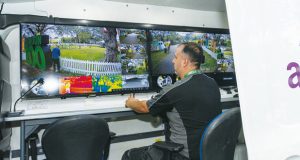 Ryan Quinn, Operations Director at doorassure – RW Joinery’s maintenance, repair, and inspection division, explores why FMs must prioritise fire door compliance – not just during Fire Door Safety Week, but all year round
Ryan Quinn, Operations Director at doorassure – RW Joinery’s maintenance, repair, and inspection division, explores why FMs must prioritise fire door compliance – not just during Fire Door Safety Week, but all year round
It’s Fire Door Safety Week, and this year, the annual initiative by The British Woodworking Federation falls at a poignant time, just weeks after the release of the Grenfell Inquiry’s Final Report and a fire at a block of flats in Dagenham, which sparked fresh debate about the safety of buildings in the UK.
Fire doors are a legal requirement in all non-domestic properties, including commercial premises, public buildings, blocks of flats, and houses of multiple occupancy (HMOs). Under the Fire Safety Act 2021 and Regulations 2022, formal regulations now govern the installation and performance of fire doors and require responsible parties to undertake more regular inspections and maintenance.
What’s the issue?
Research from the Federation over the last few years has revealed that more than half (57 per cent)¹ of the public can’t spot issues with fire doors, such as damage to the door’s integrity, cracks in the glass or gaps in the frame. Three-quarters² of those surveyed know that propping open a fire safety door prevents its effectiveness—yet almost half³ of people wouldn’t report that issue, and just over a fifth⁴ wouldn’t report a problem as they don’t think anything would be done to remedy it.
For FMs with fire door safety responsibilities, the figures reiterate the importance of creating a culture of openness and action to encourage building users to report issues. They also show why regular inspection of fire doors is crucial.
It’s not just the public that can’t spot issues with fire doors; lack of knowledge is prevalent among building, estate and facilities managers, too. On average, 85 per cent of the fire doors we inspect fail to meet British standards, and in some settings, such as healthcare, failure rates have been as high as 100 per cent.
Fire doors aren’t something to install and forget about. They should be checked regularly by those responsible for the building and need professional maintenance and inspection every six months to keep them performing at the highest levels. Many FMs don’t know they are responsible for the integrity and performance of the doorsets and, crucially, the risk associated with their non-performance and compliance.
The six-point check
Committing to regular checks is a must to keep fire door safety front of mind, not just this week but every week. This will help maintain their upkeep, keep buildings and their occupants safe, and ensure you remain on the right side of the law.
So, how safe are your doors? FMs can use this simple six-point checklist to guide themselves and other team members through a check – but remember, only trained and certified professionals should be used to conduct official inspections, maintenance or repairs.
- Frame, seal, clearance and gaps
Take a good look at the doors’ frames and seals. Is there any damage or signs of wear with the door sitting in the frame?
The intumescent seals must be securely attached to the groove that runs along the door frame and continuously around the entire door set, as these play a vital role in the door’s effectiveness. These seals expand when subjected to heat, so clearance needs to be consistent around the door leaf and frame to ensure a tight seal in the event of a fire.
- Latches and locks
All the latches, locks, and hinges must be in complete working order and show no apparent signs of wear or anything that may hinder their operation during a fire.
- Hold open devices
Wedging a fire door open is dangerous, but specialist fire door ‘hold open’ devices exist to secure the door open during normal day-to-day operations, improving ventilation and accessibility. Confirm that they function by releasing and closing the door in response to the alarm or any power loss.
- Glazing
Glazing and vision panels should be fully intact and show no signs of defects. This is crucial for effectively containing smoke and fire.
- Smooth operation
Check that the door swings in the proper direction and is not hindered by any obstruction that would stop it from closing correctly. Doors should open and close smoothly without catching or binding to remain compliant.
- Clear and present signage
Signage is essential in guiding staff, visitors, and residents during emergencies. Can it be seen and read easily? Check that it’s in good condition, prominently displayed, and not covered by anything.
Important lessons
As many as 75 per cent of failed fire doors could be repaired, and almost all of them could have been avoided if a regular maintenance programme had been in place. Only through regular maintenance, repair and inspection can FMs be sure they’re fulfilling their obligations and keeping their building users as safe as possible.
It may not be realistic for busy FMs and estate managers to know the state of every door all the time, they should have the assurance of a BM Trada accredited partner who regularly inspects, maintains, and tests their doors. They will be able to identify potential issues, carry out repairs and replacement as necessary and ensure all aspects of compliance are achieved. The support and the peace of mind that secures is invaluable.
Sources:
[1] Source: Data from the British Woodworking Federation’s Recognise It Report It research from 2023. https://www.firedoorsafetyweek.co.uk/
[2] Source: Data from The British Woodworking Federation’s 2022 survey as quoted here: https://www.firedoorsafetyweek.co.uk
[3] Souce: Data from The British Woodworking Federation’s 2022 survey as quoted here: https://www.firedoorsafetyweek.co.uk/
[4] Source: Data from The British Woodworking Federation’s Recognise It Report It research from 2023 https://www.firedoorsafetyweek.co.uk/app/uploads/2023/09/BWF-FDSW23-video.mp4




